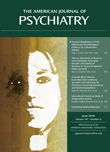Increasing the Age at Onset for ADHD?
To the Editor: In their commentary, published in the January 2010 issue of the Journal, Christian Kieling, M.D., et al. (1) presented the rationale for a DSM–5 proposal to increase the required age at onset for attention deficit hyperactivity disorder (ADHD) from age 7 years to 12 years. Unfortunately, the commentary did not include a risk/benefit analysis. The authors focus only on the benefit of reducing false negatives and ignore the considerable risk that eliminating this age of onset gatekeeper will result in a flood of new false positives for a diagnosis that may already be quite overinclusive.
Especially in adolescents and adults, real or perceived attention problems are so common and so nonspecific that ADHD can be easily overdiagnosed in those suffering from any number of other mental disorders and in those who are merely seeking performance enhancement (2–6).
1 : The age at onset of attention deficit hyperactivity disorder. Am J Psychiatry 2010; 167:14–15 Link, Google Scholar
3
4 : National trends in the treatment of attention deficit hyperactivity disorder. Am J Psychiatry 2003; 160:1071–1077 Link, Google Scholar
5 : Illicit methylphenidate use: a review of prevalence, availability, pharmacology, and consequences. Curr Drug Abuse Rev 2009; 2:157–176 Crossref, Medline, Google Scholar
6



